8 fiberglass cars that made plastic fantastic
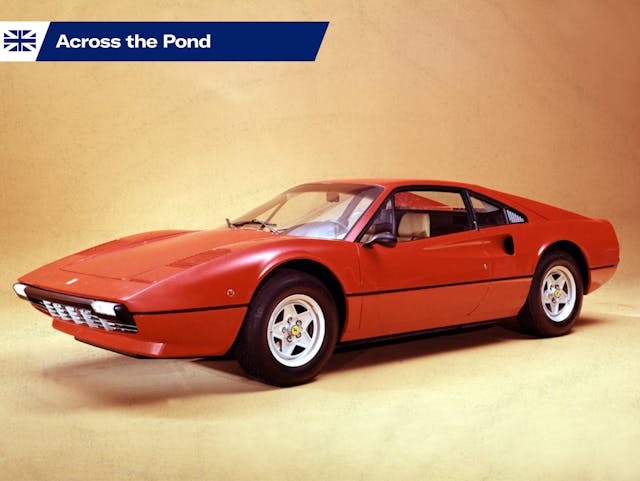
The Corvette may be the most popular fiberglass-bodied car by volume, but it wasn’t the first—and it certainly isn’t the most exotic. Have a read of this list, compiled by our U.K. colleagues, and reinforce your belief in the fantastic possibilities of plastic. —Ed.
Though the British motor industry has been doing fantastic things with plastic for around seven decades, the history of fiberglass body construction goes back even further. In his excellent book Excess All Areas: British Kit Cars of the 1970s, Richard Heseltine charts the use of fiberglass in the United States, kickstarted in 1936 by the Owens-Illinois glass company and its pioneering use of continuous fibers of glass, using the trade name Fiberglas.

Five years later, Henry Ford unveiled the Soybean Car (above), which utilized 14 plastic panels attached to a steel tubular frame. According to The Henry Ford Museum of American Innovation, the body’s ingredients included soybeans, wheat, hemp, flax and ramie.
Today, the use of fiberglass is synonymous with the British specialist and sports car industries, but it’s a truly global affair.
1953 Chevrolet Corvette

The American Bill Tritt had been building fiberglass boats for two years when he was approached by friend Major Ken Brooks. Tritt was tasked with creating a European-style roadster based on the chassis of an old Willys Jeep, in which Brooks’ wife refused to travel. The result was the Brooks Boxer, which became the Glasspar G2, a car credited as being the world’s first fiberglass sports car.
Tritt went on to design and build fiberglass cars for a range of companies, but his role in the creation of the Chevrolet Corvette is often overlooked. The G2 was presented to Harley Earl, General Motors’ vice-president in charge of styling. For Earl, it was a source of inspiration; the use of Glass-Fiber-Reinforced Plastic (GRP) would save money on tooling while underlining the Corvette’s position as the American sports car of the future.
GM’s promotional material extolled the virtues of the Corvette’s “two-passenger, open-cockpit body of glass-fiber reinforced plastic; light, strong, durable, rustproof, quiet and easy to repair.” For New Yorkers at the 1953 Motorama, plastic truly looked fantastic. And so began seventy years of series production.
1958 Jensen 541
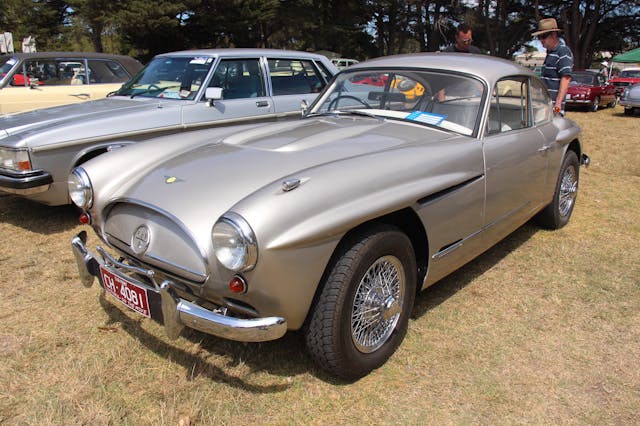
On the other side of the Atlantic, Jensen was readying the world’s first four-seater car—and Europe’s first series production performance car—with a fiberglass body. The combination of a 4.0-liter straight-six engine and lightweight, aerodynamic body made it one of Britain’s fastest cars of the 1950s.
Jensen remained faithful to fiberglass construction with the 541R (pictured), 541S, and C-V8, before the arrival of the Interceptor in 1966 saw a return to a steel body shell.
1961 Lotus Elite

The Lotus Elite was one of the most revolutionary and significant cars of the 1950s. Unlike the Corvette, whose fiberglass panels were mounted on a separate chassis, the Elite featured a monocoque built entirely of fiberglass. This was the first time fiberglass had been used for the whole load-bearing structure of the car. The result was a car that weighed about the same as a bag of sugar, with a drag coefficient of just 0.29—in 1957!
The first 250 bodies were built by Maximar Mouldings of West Sussex, before quality issues saw the work being handed to the Bristol Aeroplane Plastics Limited. In an advertisement, Bristol called it “the most advanced car body ever built.” The copywriter probably had a point.
1958 TVR Grantura

A list of fiberglass cars wouldn’t be complete without a TVR, so it makes sense to feature the marque’s first production vehicle. The Grantura of 1958 featured a fiberglass body molded to TVR’s own tubular steel chassis, with the trailing arms and torsion bars from a Volkswagen Beetle.
Other components shipped in included the windscreen from a Ford Consul and the drum brakes from an Austin-Healey 100, along with a choice of engines sourced from Coventry Climax, Ford, and BMC.
1959 Daimler SP250
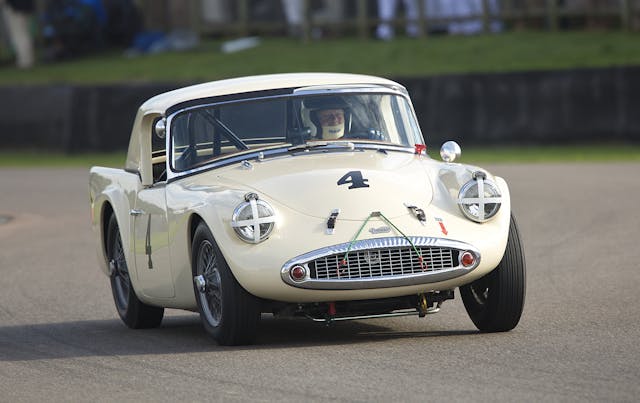
In some ways, the Daimler SP250 was the British Corvette. Launched as the Dart at the 1959 New York motor show, Daimler was forced to change the name to SP250 following a trademark complaint from Dodge.
Slow sales meant that the V-8-engined SP250 was the last hurrah for Daimler; the company was bought by Jaguar in 1960, before the axe fell on the sports car in 1964.
1970 Bond Bug
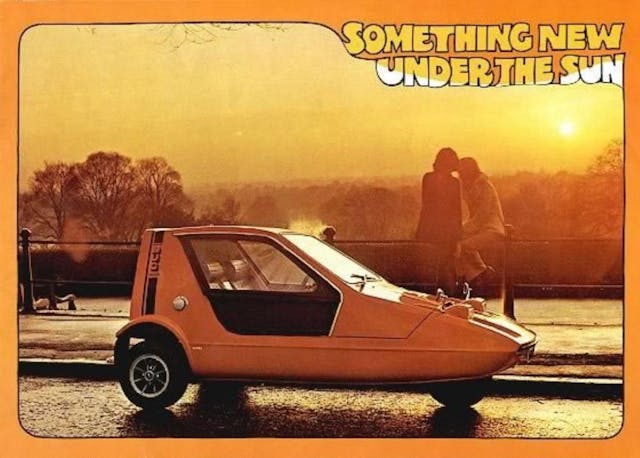
In an interview published in Classic.Retro.Modern. magazine, design genius Tom Karen named the Bond Bug and Marble Run as the two products of which he is most proud. With its orange paintwork, wedge shape, and black decals, the Bug is one of the most 1970s cars of the 1970s. In other news: It’s too long since we played Marble Run.
The brochure delivered a gloriously informal assessment of the benefits of a fiberglass body: “Rap the side of the Bug with your knuckle. There is no hollow, tinny sound; it gives a deep, solid thunk-thunk-thunk. The body of the Bug is made not of metal but of tough, reinforced glass fibre. There is a big advantage to you; because glass fibre cannot rust.”
Makes you thunk, doesn’t it?
1975 Ferrari 308 GTB
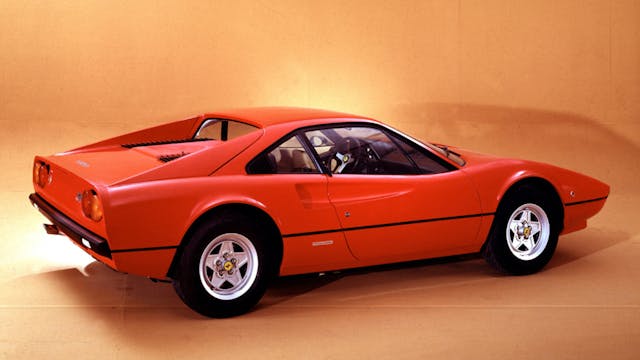
Many car names sound better in Italian: Quattroporte (four doors), Topolino (little mouse), Scuderia (stable), and Testarossa (redhead). So, it’s no surprise that the Ferrari 308 GTB “Vetroresina” sounds more exotic than the 308 GTB “Fiberglass.”
This was the first production Ferrari to feature a fiberglass body, but why did Maranello shift from steel? Probably because Ferrari needed to fast-track the development of a new car in response to the slow-selling 308 GT4. The subject of weight also played a part, while some historians speculate that Ferrari used fiberglass in case the car didn’t sell.
By late 1976, just a year after the 308 GTB made its debut at the Paris motor show, cars were arriving in the U.S. wearing steel bodies, although fiberglass cars remained on sale in Europe until the middle of 1977. Various reasons have been tabled for the switch from plastic to steel, including difficulty in finding specialists to repair accident damage, construction that was more labor-intensive than envisioned, and even the fact that fiberglass was never anything other than a temporary measure.
1977 Matra Rancho
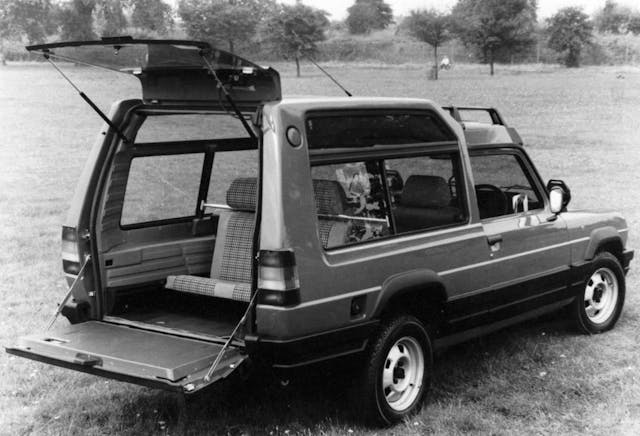
Forget all the nonsense about the Nissan Qashqai being the first crossover. Plenty of other manufacturers had previously attempted to blaze the trail, most notably the Matra Rancho of 1977.
Built to satisfy the needs of would-be Range Rover owners who wanted to talk the talk, but didn’t necessarily need to walk the walk, it pioneered the concept of a rough and ready SUV without the ability to venture further off-road than a dropped curb on the Kings Road.
The fiberglass rear section was mounted on a steel frame, the rusting of which doomed too many examples of the radical oddball. Matra stayed true to fiberglass construction with the development of the Renault Espace.
The others

There are countless other fiberglass cars we could have included. The Lancia Stratos, Citroën Bijou, Gilbern Invader, AC 3000ME, Clan Crusader, Vauxhall VX220, and Reliant Scimitar, to name just a few.
A separate list could feature more plastic creations from TVR and Lotus, not to mention the myriad kit cars produced during the boom in self-build vehicles. But before we further extol the virtues of the body material, read how difficult it can be to properly restore a fiberglass body.
Check out the Hagerty Media homepage so you don’t miss a single story, or better yet, bookmark it.


Don has a wonderful idea. And certainly the Lotus design is beautiful.
and let’s not forget the SAAB Sonett! Originally as an open 2-seater with a 3-cylinder 2-stroke engine (guaranteed for LIFE I might add), owing to American emission laws, it adopted the German Taunus (Ford) V-4 powerplant, which lasted till it’s last year of 1974. One could argue the Sonett was the FIRST front-wheel drive sports car…. the later body style had a drag coefficient of .31 (better than a Ferrari)
This bring to mind the old Corvette T-shirts: Wrap your *** in fiberglass! LOL
And I do, 73 L82 5-speed
Spastic Plastic is what my cousin Doug calls them !
The Berkeley deserves a mention- I remember them racing against the Saabs and VWs and Deutsch-Bonnets when I was a kid- lots of 2 stroke smoke and corn popper sound….
Hey ! Where’s the Morgan +4+ ? 🙂
No mention of the LaDawri? They were the #1 fiberglass body producer in 1960. You buy a body from them and they give you a list of parts to go buy at the junk yards. The windshield was from a 1957 Chev pick up truck, to be installed upside down. For the engine , they recommended the 283 V-8 from the Corvette. For tail lites, 1950 Pontiac( round). The fiberglas interior was designed like the early Corvette. The dash would accept round Stewart Warner gauges. The body was designed to bolt up the frame of the 1951 Henry J, but you could just make tour own. This car even made the cover of the July 1957 Cover of Road and Track! There were a few different models with the most common one being the “Conquest”. A fiberglass hard top was optional. They were produced starting about 1956 in Long Beach, Ca. and Yes, I have one…
Saab Sonett I (1956) all prototypes. Saab Sonett II, V-4, and III, over 10 thousand sold, most in the USA.
All my fun cars are plastic, ERA Cobra, Lotus Esprit, Elan, Europas, and Elise. “Better things for better living … through chemistry”
No mention of the Volvo P-1900 either.
I am also writing to complain about the Studebaker Avanti being left out. My 1963 was a great automobile, one of the best I have owned. It was also one of the safest cars built.
I must add the 1965 Marbon Chemicals CRV and AMT Piranha designed by Gene Winfield (remember the Man From U.N.C.L.E. car). Marbon Chemicals wanted to convince the big three automakers that Cycolac ABS (acrylonitrile-butadiene-styrene (think old telephones, luggage and safety helmets) was viable for automotive use. Nicholas K. Whitlow wrote a great book about it called The All-Plastic Car. One shell came up for sale recently and Gene Winfield would complete it to the buyer’s specification. Another vehicle I should have bought and passed on.
In 2021 I bought a 1980 Rokstock Turbina GT. Two hundred units were planned , only one made. Just about to start getting it back ready for the road. Interesting car, with a unique story of course , as all these fiberglass bodied cars have. Not a kit car , built ready to drive , and apparantly satisified DOT requirements . It came with its period sales brouchures and literature , and a list of automotive magazines it was mentioned in from 1977 to 1980 . Road and Track, Popular Hot Rodding ,Motor Trend , and others . Kinda fun . The sales literature says the body is a modified Kelmark GT, so it has that 246 Dino look . Anyone ever heard of it ? Should be a fun project !
Porsche 904, if we may include racing machines.
Volvo P-1900 ?
I had a couple of old beaters that had more fiberglass and bondo than metal left on them. Does that count? Didn’t make the list I see.